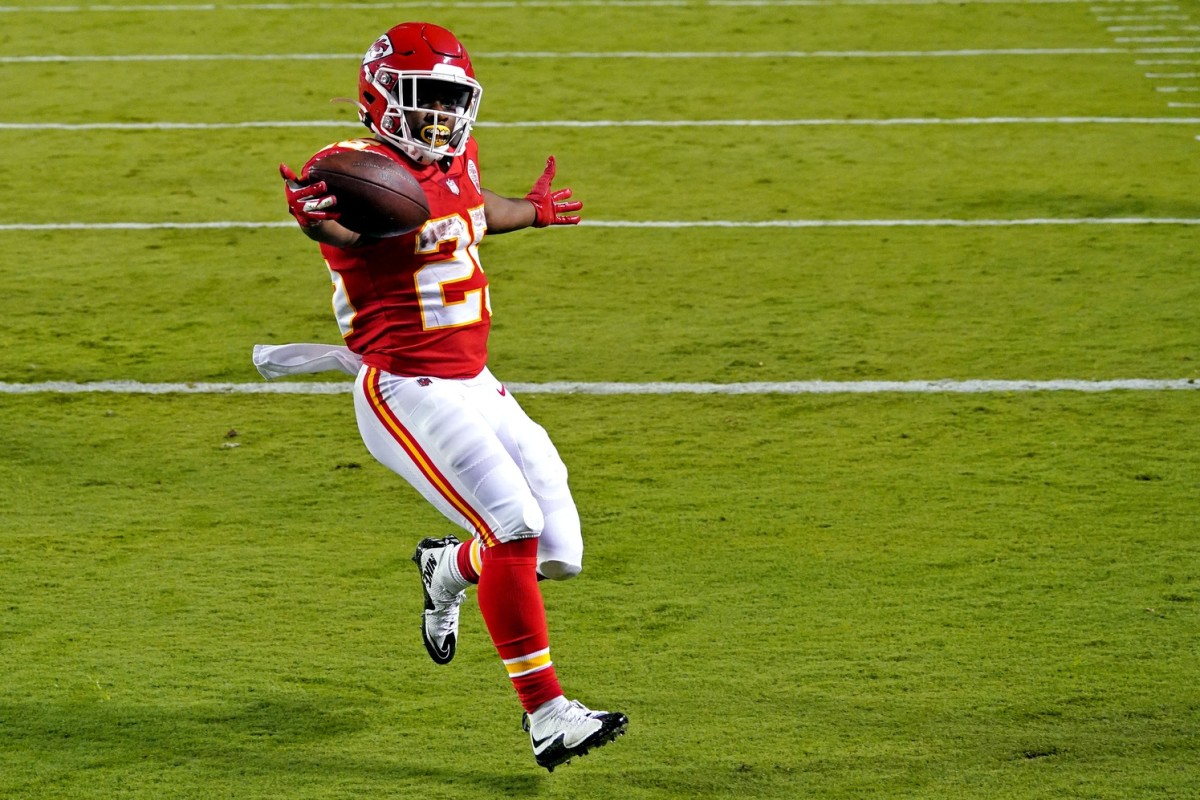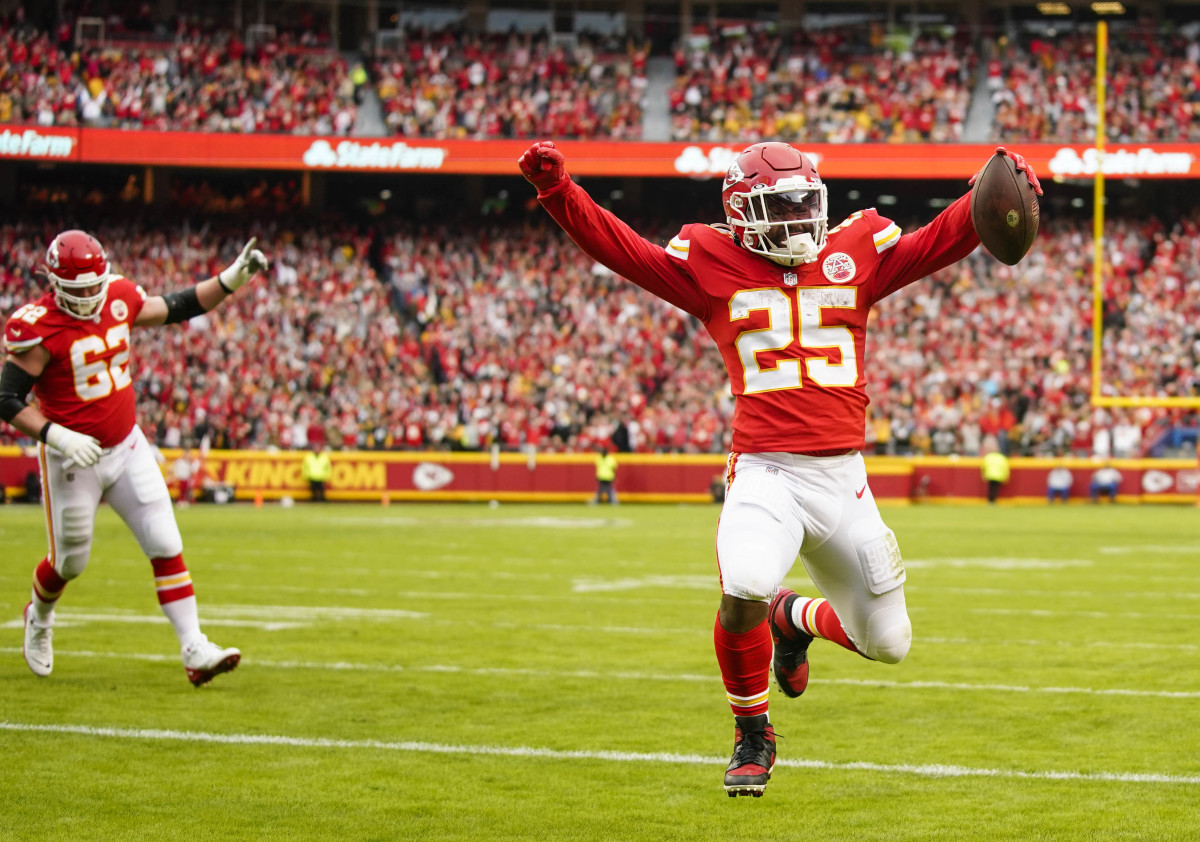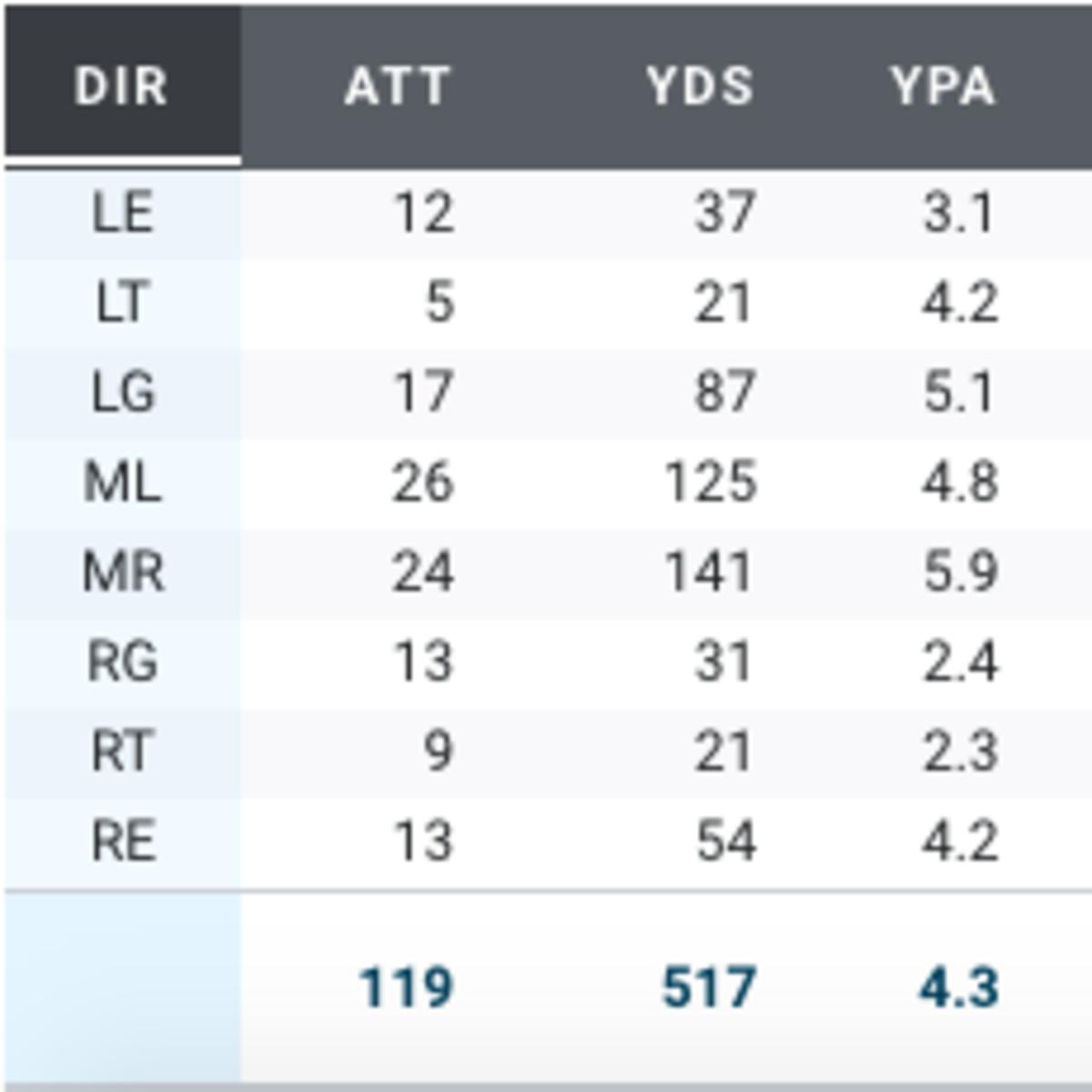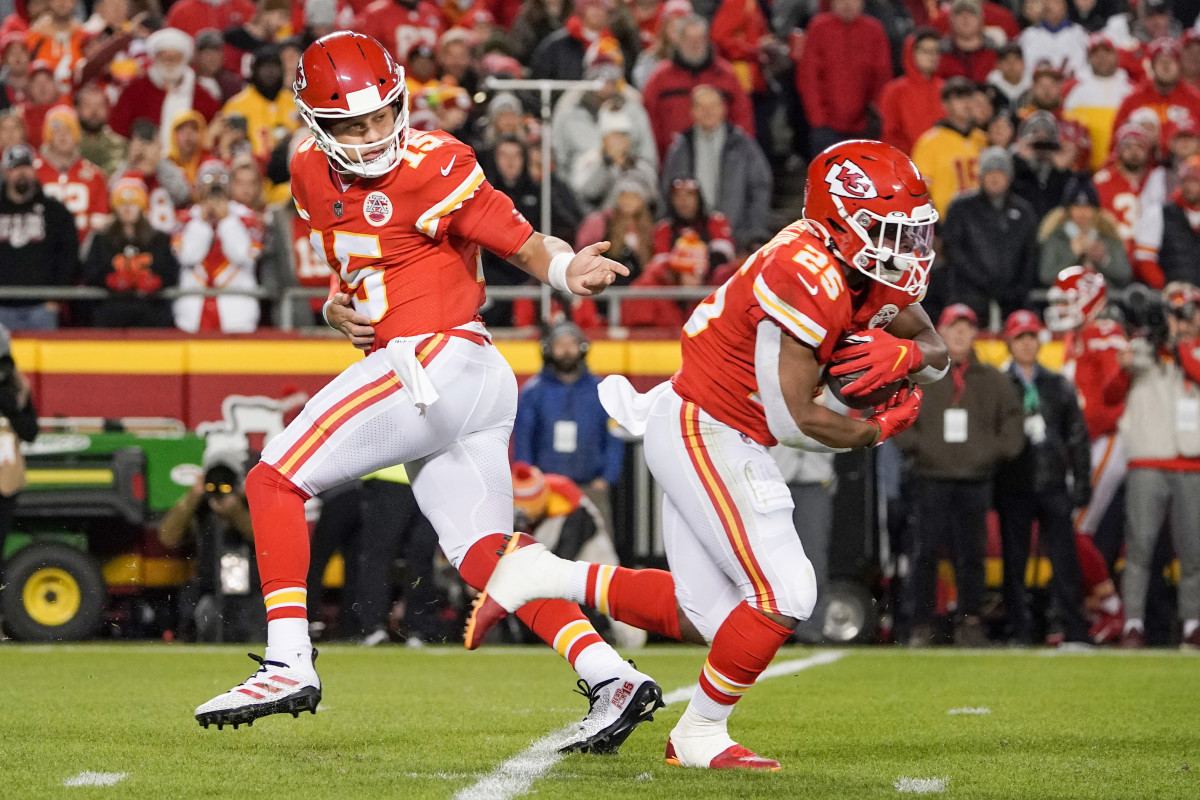Film Review: How the Chiefs Can Maximize Clyde Edwards-Helaire in 2022
With the No. 32 overall pick in the 2020 NFL Draft, the Kansas City Chiefs selected LSU running back Clyde Edwards-Helaire. Fresh out of the SEC, he was projected to be a perfect fit for the Chiefs' offense. Though Edwards-Helaire was an excellent rusher at LSU, he stood out most in the passing game, frequently making defenders look silly in the open field. Those skills were on display during his first few NFL games. He burst onto the scene, appearing to be the missing piece to what was already the league’s best offense. However, recent times have been rockier for Edwards-Helaire.
Now entering his third season and with a decision on his fifth-year contract option looming, it's Edwards-Helaire's time to prove if he can become a top-level NFL running back.

Benefit of the Doubt
This is the first full offseason that Edwards-Helaire will have since entering the NFL. All draftees are at a disadvantage entering their rookie season. They go from their collegiate season to pre-draft workouts to rookie camp before OTAs and training camp. Edwards-Helaire's season extended through LSU's national championship game victory in 2020 before entering the NFL's first COVID-impacted offseason. All these disadvantages entering his rookie season may have contributed to Edwards-Helaire hitting the "rookie wall" later in the year.
Edwards-Helaire appeared to have a full offseason before last year, but he later revealed he had gallbladder surgery after Super Bowl LV.
“This will be actually my first offseason being able to do a full training regimen. After the Super Bowl last year, the first Thursday in March, I had gallbladder surgery. My gallbladder completely stopped working. I was down to about 160 pounds and then before I knew it, it was my first time of getting a rep with the football from the Super Bowl was the first OTA practice. I didn’t run, didn’t do anything all the way up until that point, and was still dealing with stitches and recovery over the course of the summer.”
— Clyde Edwards-Helaire on the Arrowhead Addict podcast
Edwards-Helaire hasn’t had a real offseason and has dealt with numerous injuries during his first two years in the NFL. Having an entire offseason for the first time may help him take that next step.

Statistical Output
As a first-round draft pick, Edwards-Helaire has been statistically underwhelming. He hasn’t provided the rushing boost that the Chiefs were looking for. He has racked up less than 850 rushing yards in each of his two seasons. In his sophomore year, Edwards-Helaire’s role was significantly reduced. He only had 11.9 carries and 2.3 targets per game versus the 13.9 carries and 4.15 targets per game he saw in his rookie season. His snap percentage was also down from his rookie season to his sophomore season. While Edwards-Helaire's role and production decreased, the Chiefs' rushing offense actually improved. In 2020, the Chiefs were 13th in rushing EPA. While in 2021, they were eighth.
Throughout his first two seasons, Edwards-Helaire has lacked consistency. Edwards-Helaire has played in 27 of a possible 39 games. He has rushed for over 100 yards four times while rushing for under 50 yards 15 times. Though his yards per carry numbers have been solid, he hasn’t found the consistency to rush for 1,000 yards.

Strengths
Edwards-Helaire is built like a bowling ball and uses it to his advantage. He is short and stocky, which allows him to be most effective between the tackles. He is able to hide behind the bigger offensive linemen, which allows him to sneak through for extra yards. His short choppy steps help him make quick cuts to evade defenders.
Another example of Clyde using his size to run between the tackles. When he sees the new opening he quickly cuts to get there. Also, he gets small when contact is arriving, which pushes him forward for a few extra yards. #Chiefs pic.twitter.com/JcHUty4XJS
— Zack Eisen (@zackeisen21) June 1, 2022
One of the first traits that pops on film is his open-field acceleration. Edwards-Helaire is not fast, but he has good build-up speed. Once he gets to the second level of the defense, he can cover ground quickly.
I think an underrated part of Clyde's game is his build-up speed. He isn't the fastest within the first few yards, but once he gets going, Clyde accelerates pretty well. #Chiefs pic.twitter.com/nvK9X285TV
— Zack Eisen (@zackeisen21) June 1, 2022
Here, Edwards-Helaire hits the hole and accelerates to the second level leading to his longest run of the season. He pulls away from the linebacker, leading to a one-on-one matchup with the safety. Edwards-Helaire gains extra yards by sidestepping the pursuing defender. This is a normal occurrence for him in the open field. He possesses elite lateral agility. This trait allows him to sidestep or jump-cut as the pursuing defender flies by, or he can bounce from one hole to another in a quick manner.
Edwards-Helaire has a unique ability to make defenders miss when making contact with them. In college, he was playing against Alabama in a goal-line situation. As he and the defender were making contact, he spun, allowing him to stay on balance and score. We saw a similar play last year against Pittsburgh.
Clyde's best play from 2021. He uses the old adage of "low man wins." Displays great contact balance before rolling into the endzone. Nice celly to cap it off as well. #Chiefs pic.twitter.com/TC5LP81vSm
— Zack Eisen (@zackeisen21) May 31, 2022
Naturally, Edwards-Helaire is smaller than most defenders, so he uses this to his advantage. He makes sure to embrace the contact by getting lower than the defender before bouncing off and walking into the endzone. What this touchdown represents is Edwards-Helaire's elite contact balance. For a player his size, he rarely goes down on the first hit, even continuing his path after contact. He will stay on his feet in the open field with a plethora of moves, from a duck-under to a spin move to a jump-cut. You name it, Edwards-Helaire most likely has it in his bag.
A goal for the #Chiefs should be to utilize Clyde in the passing game more. In open space, Clyde is at his best. Though he didn't make this a huge gain, he was able to pick up extra yards by making defenders miss in the open field. pic.twitter.com/EvSOZP7pXL
— Zack Eisen (@zackeisen21) June 1, 2022
We see this here when Edwards-Helaire catches a pass out of the backfield. He sidesteps the first defender before ducking under the second one. The ability to make guys miss in the open field is special. Whether the defender has made contact or not, Edwards-Helaire makes it incredibly hard for the defender to bring him to the ground. Getting Edwards-Helaire into more open-field situations should be a goal for the Chiefs. They can do this by utilizing him more in the passing game.
Edwards-Helaire was highly touted coming out of college because of his receiving ability. Whether he was lined up on the outside or catching a pass from out of the backfield, Edwards-Helaire excelled. He has shown that ability at the NFL level. When he has gotten the opportunity to catch passes in the open field, he has made a positive play from it.
Clyde makes things happen in the open field. The #Chiefs coaching staff should be trying to find ways to get Clyde more touches in the passing game. Whenever he has had the opportunity, he has made a play. pic.twitter.com/fjosaRzgnZ
— Zack Eisen (@zackeisen21) June 1, 2022
Weaknesses
The number one weakness of Clyde Edwards-Helaire is his speed. He ran a 4.6 40-yard dash during the pre-draft process. That time shows on his tape. He lacks the speed to break away from opponents. The Chiefs have made an effort to get faster at the position over the last few years. Last year they brought in Jerick McKinnon, and this season, they drafted the fastest running back in the draft in Isiah Pacheco. The problem for Edwards-Helaire is that speed is not an ability you can drastically improve. You are either born with it or not. Unfortunately for him, he wasn’t, and it hurts him in certain situations.
Of course, that lack of speed comes back to hurt you in situations like this. The offensive line gives a massive hole for Clyde to run through. This should be a walk-in touchdown, but Clyde doesn't have enough initial pop to score. #Chiefs pic.twitter.com/sBtiEgVYKs
— Zack Eisen (@zackeisen21) June 1, 2022
Edwards-Helaire doesn’t have the initial burst to score here. The offensive line does an excellent job blocking up front and there is a massive hole for him to run through. However, due to his lack of speed, he is unable to capitalize on this play.
The second thing that I noticed that gets Edwards-Helaire in trouble is his vision. Unlike speed, vision is something that you can improve through reps and film study. However, right now, it doesn’t seem like Edwards-Helaire sees the field as well as you’d like. This especially happens in the run game. Whether it is because of his size or another factor, he often chooses the wrong hole when carrying the football.
Vision, Vision, Vision. You can really see it in the endzone view. Clyde has a hole up the middle but tries to go with his blockers and runs right into their backs. #Chiefs pic.twitter.com/73T0XaXWlt
— Zack Eisen (@zackeisen21) June 1, 2022
Edwards-Helaire can burst through the hole and follow Orlando Brown Jr. on this play. However, he feels that he can pick up more yards by going behind the blockers on his right. What he fails to notice is that Micah Parsons has already beaten Andrew Wylie around the corner and is closing in. Edwards-Helaire is then forced into running straight into the backside of his linemen for a mere three-yard gain.
Even in the open field, you can see Edwards-Helaire make questionable decisions. Answer this for me:
If you are Clyde, which direction are you going? Back inside or staying outside. pic.twitter.com/417191aN98
— Zack Eisen (@zackeisen21) May 31, 2022
Edwards-Helaire has beaten the first two levels of the defense. He has two wide receivers blocking on the outside which may lead to him to the end zone. The other option is cutting back inside and trying to beat the pursuing safety. Personally, I would have continued outside. There are blockers in front and you don’t have to slow down and change direction. Here, Edwards-Helaire cuts back, his cut takes too long, and he is caught from behind.
This is what frustrates me about Clyde. The OL provides him with great blocking, but he thinks too much about his next move. Instead of continuing outside behind WRs, he tries to cut back. He loses speed when he tries to do this which allowed him to be caught from behind. #Chiefs pic.twitter.com/sXP2s3m04C
— Zack Eisen (@zackeisen21) May 31, 2022
Lastly, the Chiefs' schematic fit for Edwards-Helaire isn’t ideal. When he was at LSU, the Tigers ran a primarily gap run scheme. In a gap scheme, the running back is guided to the hole they are supposed to hit. Gap also gives the option to bounce to the secondary hole if the primarily read is filled. On the other hand, the Chiefs run a primary zone run game. This scheme gives the running back freedom to see the play develop and choose which hole to hit. When Edwards-Helaire was told which hole to hit, he was a much better runner. He was able to attack downfield, and if the hole got closed up, he could bounce to the secondary gap. Edwards-Helaire is at his best attacking downhill without much thought.
2022 Outlook and Beyond
With the decision on a fifth-year option looming, the Chiefs need to see Edwards-Helaire’s best. So how do they get that out of him?
First, the Chiefs need to use Edwards-Helaire more in the passing game. Not only can he line up anywhere on the field, but he can run the entire route tree. This has been under-utilized during his time with the Chiefs. Most of his receptions have come in the flats or on out-breaking routes. LSU had Edwards-Helaire run Texas, option and corner routes out of the backfield. Get him in situations where he is one-on-one with a linebacker and choose which direction he wants to run his route. Let him use his elite agility in the open field to make defenders miss. This is the top focus for the Chiefs and Edwards-Helaire this upcoming season.
I don't know what it is, but for some reason, Clyde sees the field better as a receiver. He sees that his two blockers have their defender sealed off, so he can run right between them for the easy touchdown. #Chiefs pic.twitter.com/uZ6q9y3vTg
— Zack Eisen (@zackeisen21) June 1, 2022
Secondly, with the offensive line and Edwards-Helaire's abilities, the Chiefs should shift from a zone-heavy run scheme to primarily gap run scheme. According to Pro Football Focus, Edwards-Helaire ran 90 zone run plays versus 28 gap run plays. That's more than a 3:1 ratio, which should probably be flipped. Considering the maulers that the Chiefs have up front and Edwards-Helaire's ability, Andy Reid and the coaching staff should have a shift in running philosophy. Run concepts such as duo, and guard-tackle counter are what Edwards-Helaire has excelled at.
Now what I would like to see are more GT counter plays. Trey Smith and Blake Bell pull to open up the hole for Clyde. Someone missed their assignment which allowed for the defender to be in the hole. If it was blocked up, Clyde may still be running. #Chiefs pic.twitter.com/IVZTj8v2RM
— Zack Eisen (@zackeisen21) June 1, 2022
Here is an example of a gap run that the Chiefs ran. Trey Smith (guard) and Blake Bell (“tackle”) are originally lined up on the right side before pulling to the left side. Edwards-Helaire takes his first step to the right before countering back to receiving the handoff. The Chiefs blockers let a defender slip through, but Edwards-Helaire would have still been running if not for that mistake.
Running a gap scheme plays into Edwards-Helaire's strengths. Due to him not being the fastest, he is better as a north-south/downhill runner. In a gap scheme, it allows him to get downhill as quickly as possible as the goal is to hit the hole immediately. Certain plays in a zone scheme just don’t match his ability. For example, outside zone may be the worst play you can run with Edwards-Helaire. He doesn’t have the speed to beat defenders around the outside. Running it, especially in shotgun, does no favors for the young back.
If I could take one play out of the #Chiefs playbook, it would be outside zone. When Clyde runs outside zone it is a waste of a down. He isn't a fast guy to start, so asking him to beat defenders around the edge makes it nearly impossible for him to make a good play. #Chiefs pic.twitter.com/6KG2udwgre
— Zack Eisen (@zackeisen21) June 1, 2022
Running between the tackles is where Edwards-Helaire is at his best. His average in yards per carry drops almost two full yards when he is running off-tackle versus between the tackles.

Lastly, Edwards-Helaire has got to stay healthy. He suffered a number of injuries throughout his NFL career. At the end of his rookie season, he had a hip/groin injury that knocked him out for a month. Last year, he sprained his ankle in Week 6. A few weeks after his return, he hurt his shoulder in Week 16. Running back is a position of attrition. He can't be the best version of himself without being on the field.

Edwards-Helaire does enter this critical season with a huge advantage. He gets to play with Patrick Mahomes. Since defenses are so scared of Mahomes beating them with his arm, they take defenders out of the box. This creates lighter boxes, theoretically making it easier to run the ball. Edwards-Helaire needs to take advantage of this. There is no other situation that provides you with these light-box looks. The Chiefs see light-box looks at a shockingly high rate compared to the rest of the league (when adjusted for a variety of factors by Timo Riske of PFF). The Chiefs are in a different stratosphere.
After accounting for situation, offensive personnel and defensive play caller tendencies, here are the offenses who see 8 or more men in the box most often:
— Timo Riske (@PFF_Moo) June 1, 2022
Titans +6%
Broncos +5%
Patriots +3%
Here is who sees 6 or fewer more often:
Chiefs +12%
Cardinals +3%
Chargers +3%
Andy Reid has always emphasized the importance of molding his offensive system to the players. For the Chiefs to maximize Clyde Edwards-Helaire’s talent, they need to adjust and put him in the best positions possible. Get him more looks in the passing game. Let him run different routes out of the backfield. Edwards-Helaire should be put in space against defenders because he wins almost every time. Also, shift the scheme to benefit your No. 1 back. Let the offensive linemen attack downfield and have Edwards-Helaire run behind them.
Once Edwards-Helaire gets in the open field, he truly becomes dangerous because of his array of moves, contact balance, and elite agility. By doing this, the Chiefs should see the best football yet from Clyde Edwards-Helaire.
